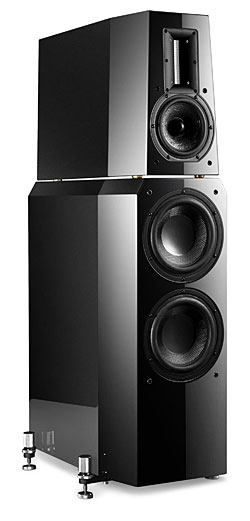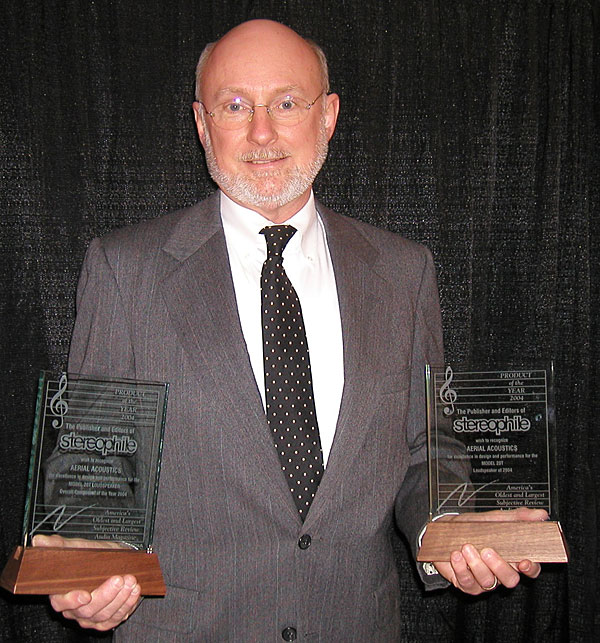| Columns Retired Columns & Blogs |
Would have been nice to learn something tangible about the actual design and performance of his speakers.
Kelly: You build the inner cabinet, then you build the outer one around it, then you clamp it down and glue it at the same time. There's also bracing. It runs through holes in the walls of the inner cabinet, and connects to the outer cabinet to reinforce the entire enclosure.
Lander: What other Aerial speakers do you see as significant?
Kelly: Our first center speaker. Back in the late '90s, home theater started to become very strong, and center speakers are critical to home theater, so we introduced our CC3. (footnote 3). It was a three-way with two rotary switches, for boundary-level compensation and system matching. I hesitate to say it was the first, but it was certainly one of the first really good center speakers. We followed that with the SR3, an on-wall, five-driver, switchable, dipole/bipole surround, which we recently discontinued after it had been in production for many years. Shortly after that, we developed what was one of the first really good subwoofers that would be fast enough to mate with speakers like Quads or Magneplanars, the SW12. It was good for music, which has always—always—been our first concern. Two-channel's always our goal, but we make things that work for home theater. That sub was good for both.
 Lander: Can you tell us anything about future Aerial speakers? A 5T will probably be available by the time this interview appears.
Lander: Can you tell us anything about future Aerial speakers? A 5T will probably be available by the time this interview appears.
Kelly: There will be a new on-wall product family, and an important new model between the 7T and the 20T V2 that is due in about a year.
Lander: You and your associates at Aerial have been so closely involved for so many years that your relationships border on kinship. You've been working alongside Dave Marshall since he joined a/d/s/ in the mid-1970s, not long after you did. That's a long time.
Kelly: A long time. I actually hired him as a draftsman. Technically, he's extremely good.
Lander: The 10T's crossover was his design.
Kelly: That crossover network was really a work of art.
Lander: Karl Brunelle, who was in production and quality control at a/d/s/, is also at Aerial.
Kelly: Karl and I go back to the 1980s.
Lander: You've also stressed the significance of relationships with suppliers, and the sub-suppliers who provide them with parts.
Kelly: My background, from a/d/s/, was designing and completely building all drivers from scratch, but we weren't large enough at Aerial to do that.
Lander: So you had to turn to OEM driver suppliers.
Kelly: By the early '90s, there were very good ones. We'd design the drivers completely, and they would build them to our specs. One of the things that Aerial has always done that's different than competitors that use standard OEM drivers is that, because we're able to design the drivers, and because we have wonderful working relationships with these companies and with the engineers in these companies, we're able to totally optimize the drivers for our designs. The result is that the system performance is better than if you had used a standard OEM driver from the same manufacturer.
Lander: Have you kept up relationships with any of the sub-supplier companies that provided components for the drivers you built in-house at a/d/s/?
Kelly: The Dr. Kurt Müller company, in Germany, which makes cones and domes and surrounds—the critical soft parts, the critical moving parts of the drivers.
Lander: The Kurt Müller operation was founded prior to World War II, and is a good example of the German artisan companies you admire so much. Recently, you began a relationship with a Danish firm, Gato Audio. Why did you decide to import its hi-fi electronics?
Kelly: I really believe in what they're doing. We had no electronics, and we felt we could utilize our warehouse and contacts to help them in the US market. We're basically able to do this at the same time as selling our own products, and we've become very good friends.
Lander: Friendship, an especially longstanding friendship with one of Peachtree Audio's founders, Jim Spainhour, led you to become involved with that company. Though it addresses a somewhat different market segment, you're a partner, and you do some consulting there. How did you get to know Jim Spainhour?

Kelly: He was a customer when I was working at Soundhaus. He bought a used, traded-in Dynaco Stereo 70 tube amplifier that blew up the first night he had it. I fixed it, and we've been friends from then on.
Lander: At various times, when I've called the main Aerial number, you've answered the phone yourself. Avery Fisher used to answer calls that came into the main Fisher Radio number on Saturdays, when he was working in his office at the Long Island City plant. He told me that surprised more than a few callers.
Kelly: I'm very accessible. I try to answer people's questions.
Lander: But how do you find the time?
Kelly: I'm a very hard worker. I make up for the time it takes. The other things I might have been doing during that time, I do in the evening.
Lander: You do your day-to-day work at home, in Maine, where you have a small cottage on the ocean. When you do commute to Massachusetts, is it a long drive?
Kelly: It's no problem, but I don't have to be in Wilmington to do most things. Everyone there was with me at a/d/s/ and goes back 30 years. Working the number of hours that I do, my chance for enjoyment is looking out the window. I put in a very, very large amount of hours, and my recharge is to look out the window and see something beautiful in nature.

Would have been nice to learn something tangible about the actual design and performance of his speakers.

Making cabinets out of inherently 'dead' material is always good. And it need not be crazy expensive, like some we all know of.


but I've seen a lot of cracked Novalith heads on old 10T's. There is more than one reason they dont make them anymore.